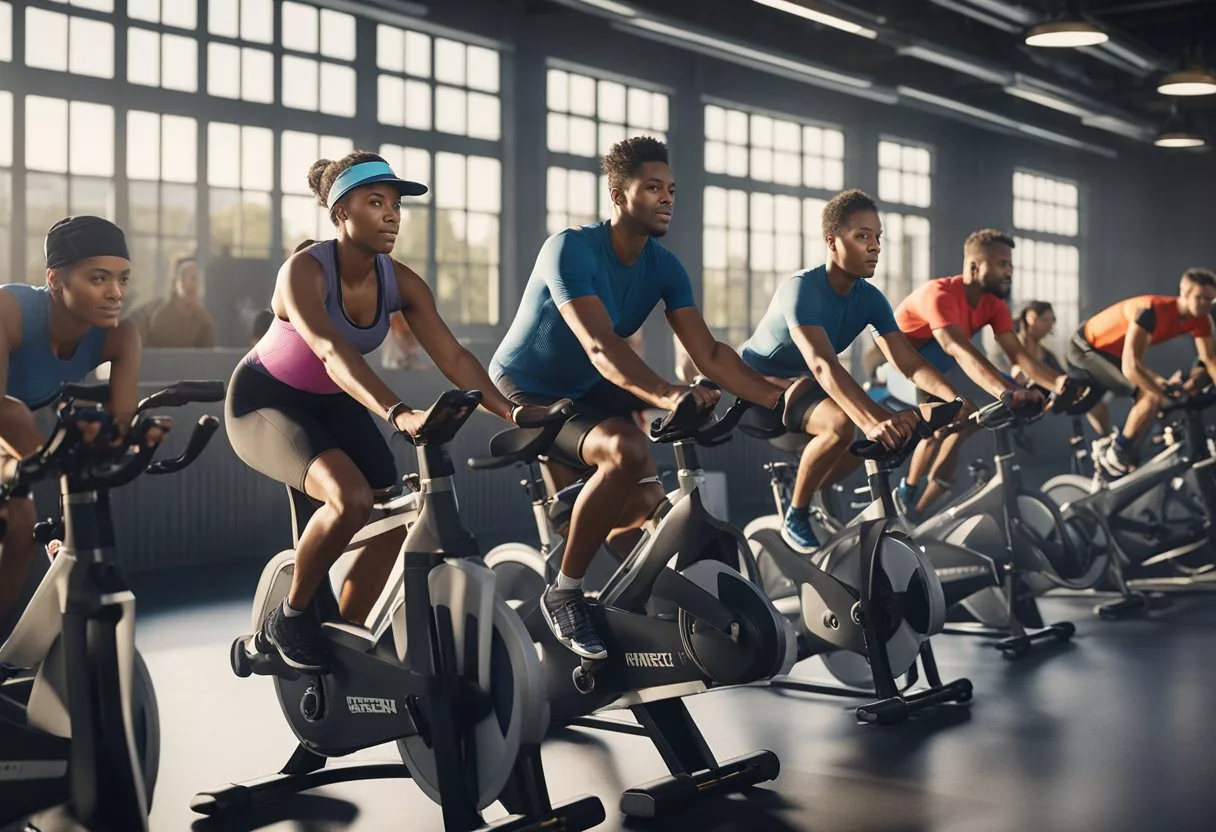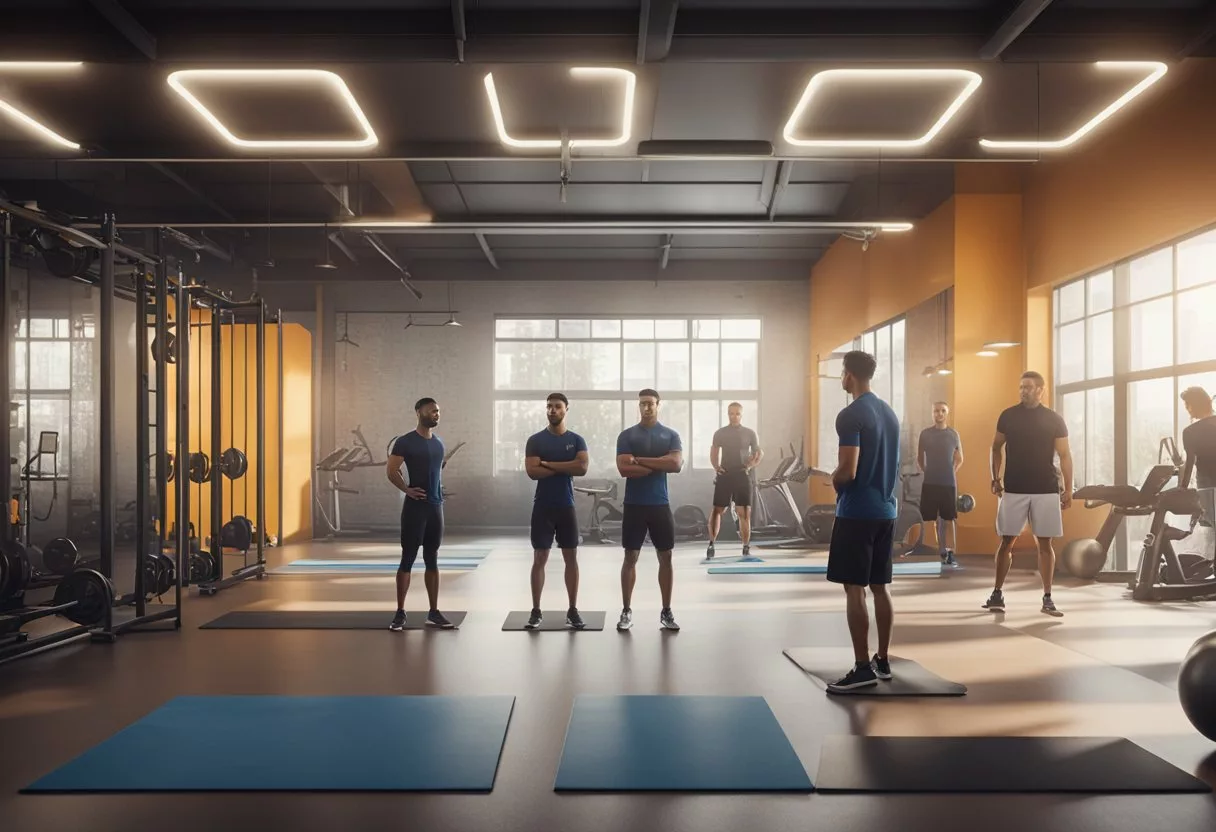Ever wondered why some workouts keep burning calories even after you finish? This phenomenon is known as the afterburn effect, scientifically called excess post-exercise oxygen consumption (EPOC). The afterburn effect refers to the increased amount of oxygen your body needs to return to its resting state after vigorous exercise, leading to continued calorie burn.

High-intensity interval training (HIIT) and weightlifting are particularly effective for maximizing the afterburn effect. During these workouts, your body works harder to return to its normal state, thus burning more calories even when you’re at rest. This post-exercise calorie burn can make a significant difference in your fitness journey, boosting both weight loss and muscle gain over time.
Understanding the afterburn effect can help you tailor your workout routines for better results. Choosing exercises that push your limits will enhance your EPOC, ensuring that your body continues to burn calories long after you’ve left the gym. Check out the in-depth guide here to learn more about how to incorporate these strategies into your fitness plan.
Key Takeaways
- The afterburn effect is the increased oxygen needed after high-intensity exercise.
- HIIT and weightlifting are effective at maximizing afterburn.
- Post-exercise calorie burn helps in weight loss and muscle gain.
Understanding the Afterburn Effect

The afterburn effect, or Excess Post-Exercise Oxygen Consumption (EPOC), is a phenomenon where the body continues to burn calories after exercise. This effect results from the body’s need to restore itself to its pre-exercise state.
Scientific Basis of EPOC
EPOC refers to the increase in oxygen consumption after intense physical activity. During exercise, the body consumes more oxygen to produce energy. After the workout, the body requires additional oxygen to repair muscles, replenish energy stores, and restore body temperature. This increased oxygen consumption leads to continued calorie burning even after the exercise has ended.
The intensity and duration of the workout directly influence the extent of EPOC. High-intensity interval training (HIIT) and other vigorous exercises typically result in a more significant afterburn effect. Studies indicate that EPOC can cause a 6% to 15% increase in calorie consumption. This means if someone burns 300 calories during a workout, they might burn up to 45 additional calories afterwards due to EPOC.
Key Factors Influencing Afterburn
Several factors impact the afterburn effect. Intensity of the workout is crucial; the harder the exercise, the longer and more substantial the afterburn effect. High-intensity activities like sprinting or intense weight training increase the body’s need for oxygen, thereby extending the afterburn period.
Duration of exercise also affects EPOC. Longer exercise sessions can extend the afterburn effect, particularly if they involve sustained effort or endurance activities. For example, longer and more intense workouts result in a more prolonged recovery phase, thus increasing the afterburn effect.
Lastly, individual fitness levels can play a role. People who are more fit may experience a different magnitude of the afterburn effect compared to those less fit, due to differences in metabolic efficiency and muscle repair needs.
Physiological Mechanisms Behind EPOC

Excess post-exercise oxygen consumption (EPOC) plays a key role in the body’s recovery process. It involves oxygen, metabolism, and energy restoration.
Role of Oxygen in Recovery
Oxygen is essential in the recovery phase after a workout. When exercise stops, the body continues to use oxygen at a higher rate. This increased oxygen intake helps to restore the body to its pre-exercise state. It assists in the replenishment of adenosine triphosphate (ATP) and creatine phosphate stores, which are vital for energy.
The heart rate and breathing rate remain elevated for a while, supporting enhanced oxygen delivery to the muscles. This process helps in clearing out the metabolic byproducts that build up during intense exercise. The boost in oxygen consumption also aids in regulating body temperature and repairing any micro-damage in muscle tissues.
Lactic Acid and Muscle Repair
During strenuous exercise, lactic acid accumulates in the muscles due to anaerobic metabolism. The presence of lactic acid can lead to muscle fatigue. EPOC facilitates the removal of lactic acid from the muscles. Oxygen plays a crucial role in converting lactic acid back into pyruvate, which can be further used for energy production in the Krebs cycle.
The repair and rebuilding of muscle tissues are important aspects of recovery. Elevated oxygen levels support protein synthesis, which is essential for muscle repair. This process helps in reducing muscle soreness and prepares the body for future physical activity.
ATP Restoration and Energy Expenditure
Adenosine triphosphate (ATP) is the primary energy currency of cells. During exercise, ATP stores get depleted. EPOC involves the restoration of ATP levels to meet the body’s energy demands. Oxygen is crucial for the oxidative phosphorylation process in the mitochondria, where ATP is produced.
This energy restoration contributes to the overall increase in metabolism post-exercise. It explains why the body continues to burn calories even after the workout has ended. The extended calorie burn can contribute to weight management and improved fitness levels over time.
Engaging in activities that foster a higher EPOC response can enhance overall energy expenditure and promote better recovery after intense workouts.
Measuring the Afterburn Effect

Measuring the afterburn effect requires specific techniques to track energy expenditure and the body’s oxygen debt during recovery. Accurate measurement is important for understanding how different workouts influence calorie burn and fitness progress.
Techniques to Gauge Afterburn
To measure the afterburn effect, start by using a heart rate monitor during and after exercise. The data from these monitors can help track how hard the heart is working, indicating ongoing calorie burn.
Another effective method involves measuring oxygen consumption. Devices that track VO2 Max can show how much oxygen the body uses after a workout. Higher oxygen consumption means a higher afterburn effect because the body is restoring itself.
The Perceived Exertion Scale is also useful. This scale helps estimate how intense the workout felt, providing insight into how much energy was spent. Higher perceived exertion usually means a longer and more significant afterburn effect.
Importance of Accurate Measurement
Accurate measurement of the afterburn effect is crucial for tailoring fitness routines. By tracking calories burned and oxygen debt, individuals gain a better understanding of their energy expenditure.
Fitness experts rely on this data to design programs that maximize the afterburn effect. It aids in creating workouts that push the body effectively, enhancing overall fitness.
Keeping track of these metrics helps maintain motivation. Seeing the concrete benefits of high-intensity workouts encourages continued effort and progress.
Accurate and detailed tracking tools ensure the most effective and personalized fitness plans. By focusing on specific data points, such as heart rate and perceived exertion, anyone can better understand their post-exercise calorie burn.
Factors Affecting Afterburn Intensity

Various factors play important roles in determining the afterburn effect, also known as excess post-exercise oxygen consumption (EPOC). These include workout intensity, exercise duration, different exercise modalities, and individual fitness levels.
Influence of Workout Intensity
The intensity of a workout significantly influences the afterburn effect. Higher-intensity exercises like sprinting or intense weight training elevate the body’s need for oxygen during and after the workout. This increase in oxygen demand boosts the afterburn effect, resulting in more calories burned post-exercise. Activities that push the body to its limits, such as high-intensity interval training (HIIT), are particularly effective. HIIT involves short bursts of intense exercise followed by brief rest periods, which ramps up the body’s recovery processes and extends the duration of EPOC.
Impact of Exercise Duration
The length of an exercise session also impacts the afterburn effect. Longer workouts, especially those involving continuous effort, can enhance EPOC. For instance, a 60-minute high-intensity workout will typically create a longer afterburn effect compared to a 30-minute session. Research shows that extended exercise duration maximizes calorie burn by maintaining a higher metabolic rate for a longer period post-exercise. The body continues to consume oxygen at elevated levels during the recovery phase, prolonging the afterburn effect.
Effects of Different Exercise Modalities
Different types of exercise can influence the afterburn effect in various ways. Aerobic activities like jogging, cycling, and swimming can trigger EPOC, but high-intensity activities yield a more pronounced effect. For example, high-intensity interval training (HIIT) leads to a greater afterburn effect compared to steady-state cardio. Tabata, speed drills, and other high-intensity exercises maximize EPOC due to their demanding nature. The body’s increased need for oxygen to restore homeostasis after these intense workouts extends the calorie-burning period.
Individual Fitness Levels and EPOC
A person’s fitness level affects the intensity and duration of the afterburn effect. Those with higher fitness levels generally experience a more efficient recovery process. Although they may still achieve a significant EPOC, it might be shorter compared to someone less fit. Conversely, beginners or those less physically conditioned may experience a prolonged afterburn effect due to the higher metabolic demand placed on their bodies. This variation underscores the importance of personalized training programs that cater to individual fitness levels to optimize EPOC benefits.
Maximizing the Afterburn Through HIIT

Maximizing the afterburn effect involves using High-Intensity Interval Training (HIIT). This approach includes quick bursts of intense activity followed by short rest periods. It boosts calorie burn for hours after the workout ends.
Principles of High-Intensity Interval Training
High-Intensity Interval Training combines short, intense bursts of exercise with rest periods.
During these bursts, exercises like sprints and Tabata routines push the body to its limits.
Following each burst with a rest period helps maintain high intensity throughout the workout. This method increases the body’s oxygen needs, leading to the afterburn effect.
Benefits:
- Efficiency: Short workouts.
- Calorie Burn: Burn calories post-exercise.
- Versatility: Many exercises and routines.
Comparison of HIIT with Steady-State Exercise
HIIT and steady-state exercise differ in intensity and duration.
HIIT:
- Short, intense bursts
- Increases metabolism
- Burns more calories in a shorter time
Steady-State Exercise:
- Longer, moderate pace
- Consistent energy use
- Suitable for beginners
EPOC (Excess Post-Exercise Oxygen Consumption) is higher after HIIT. This means the body continues burning calories long after a HIIT workout. For example, HIIT circuits might involve sprints or high-intensity cycling, while steady-state involves continuous jogging or cycling.
Designing Effective HIIT Workouts
Designing a HIIT workout requires choosing exercises, setting intervals, and considering fitness levels.
Exercises:
- Sprints
- Jumping jacks
- Burpees
Intervals:
- Work: 20-30 seconds of high-intensity.
- Rest: 10-15 seconds.
Formats:
- Tabata: 20 seconds work, 10 seconds rest, repeat 8 times.
- Circuit Training: Rotate through different exercises with minimal rest.
Balancing intensity and recovery is key. Beginners might start with longer rest periods, while advanced exercisers reduce rest to increase difficulty.
Summary Table
| HIIT Workouts | Steady-State Exercise |
|---|---|
| Short bursts | Continuous activity |
| High intensity | Moderate intensity |
| High post-workout burn | Steady calorie burn |
| Efficient | Longer duration |
Long-Term Benefits and Adaptations

Consistent exercise and the afterburn effect bring several long-term benefits. These include metabolic changes, improvements in body composition, and enhanced endurance and performance.
Metabolic Adaptations to Regular Training
With regular exercise, the body’s metabolic rate increases. This means that the body burns more calories even at rest. Over time, these adaptations result in more efficient energy use. For example, there is an increase in mitochondrial density, which helps cells produce more energy.
Regular high-intensity workouts also improve insulin sensitivity. This helps in better glucose uptake by muscles, reducing the risk of type 2 diabetes. Moreover, these metabolic changes continue to support fat loss and help maintain a healthy weight.
Body Composition Changes
Workouts that trigger the afterburn effect significantly impact body composition. These exercises help increase muscle mass. More muscle mass leads to a higher resting metabolic rate, as muscles burn more calories than fat.
Consistent high-intensity workouts also contribute to fat loss. As the body continues to burn calories post-exercise, there is a reduction in stored body fat. This not only improves aesthetic appearance but also enhances overall health markers, such as reduced waist circumference and lower body fat percentage.
Endurance and Performance Improvements
The afterburn effect isn’t just about burning calories. It also improves endurance and performance. With regular training, the body adapts by enhancing the efficiency of heart and lung functions. This means better oxygen delivery to muscles, which improves stamina.
Enhanced performance isn’t limited to cardio activities. Strength training benefits from these adaptations as well. Improved muscle recovery and strength endurance enable individuals to handle higher workloads and more intense workouts. This, in turn, leads to continuous performance improvements and the ability to push fitness limits further.
These changes collectively contribute to long-term fitness, making workouts more effective and sustainable.
Incorporating Resistance and Strength Training

Incorporating resistance and strength training into your fitness routine enhances the benefits of the afterburn effect. This approach not only boosts calorie burn post-exercise but also supports muscle growth and overall fitness.
Benefits of Combining Cardio with Strength Work
Combining cardio with strength training maximizes the afterburn effect. High-intensity cardiovascular exercises like sprinting, followed by resistance workouts, increase the body’s oxygen needs and repair cycles. This combination ensures more calories are burned during recovery, enhancing fat loss and muscle definition.
For example, engaging in a sprint workout and then performing weighted squats or deadlifts can be highly effective. This method helps in achieving both aerobic and anaerobic benefits. Such workouts improve heart health and build muscle simultaneously.
Role of Muscle Fibers in Afterburn
Muscle fibers play a crucial role in the afterburn effect. There are two main types: slow-twitch and fast-twitch fibers. Fast-twitch fibers, activated during high-intensity strength training and plyometrics, contribute more significantly to the afterburn.
Exercises like heavy lifting or explosive movements increase the demand on these fibers, leading to more calorie burn post-workout. Fast-twitch fibers repair and grow during recovery, which is metabolically expensive, thereby increasing afterburn.
Knowing how different muscle fibers react to workouts helps in planning effective routines. This encourages a focus on high-intensity activities to maximize the benefits.
Sample Resistance Training Exercises
Incorporating specific resistance training exercises can effectively trigger the afterburn effect. Here are some key exercises:
- Deadlifts: This compound movement works multiple muscles at once, including the legs, back, and core.
- Squats: Both bodyweight and weighted squats engage the lower body muscles and core.
- Bench Press: Targets the chest, shoulders, and triceps, promoting upper body strength.
- Pull-Ups: Enhances upper body strength by working the back, biceps, and shoulders.
- Plyometrics: Jump squats and box jumps are explosive exercises that activate fast-twitch fibers and enhance cardio and strength.
Consistency in these exercises, combined with proper intensity, ensures an optimal afterburn effect, promoting fat loss and muscle gain.
Alternative Cardiovascular Exercises to Enhance EPOC

To effectively enhance EPOC, or excess post-exercise oxygen consumption, certain aerobic activities, balancing the intensity and duration, and including moderate-intensity workouts can be highly beneficial.
Types of Aerobic Activities
Engaging in various aerobic exercises can boost EPOC. Jogging is a simple and effective way to elevate heart rate and stimulate afterburn. It is suitable for most fitness levels and can be done outdoors or on a treadmill.
Cycling, whether on a stationary bike or outdoors, is another excellent option. It can be adjusted for intensity, making it versatile for any fitness level. Cycling uses large muscle groups, which helps increase calorie burn during and after the workout.
Swimming provides a full-body workout that also enhances EPOC. It combines cardiovascular exercise with resistance, as water increases effort. Different strokes can vary intensity, providing a customizable workout to suit varying fitness levels.
Balancing Intensity and Duration
The balance of intensity and duration is crucial for maximizing EPOC through cardio exercises. High-intensity interval training (HIIT) involves short bursts of intense activity followed by rest periods. For example, alternating between sprinting and walking can significantly boost afterburn.
However, short and intense sessions are not the only way to increase EPOC. Engaging in longer, moderate-intensity sessions can also be effective. A 30-minute vigorous cycling session could produce more afterburn than a steady 60-minute bike ride.
It is important to listen to the body to avoid overtraining. Finding a balance that includes both high-intensity and lower-intensity activities can help maintain fitness levels and enhance EPOC without excessive strain.
Role of Moderate-Intensity Workouts
Moderate-intensity workouts are those that elevate the heart rate to a level where one can talk but not sing. Activities like brisk walking, light jogging, or gentle cycling fit into this category. These exercises help maintain cardiovascular health while still contributing to the afterburn effect.
Moderate-intensity aerobic exercises are particularly beneficial for beginners or those recovering from injuries. These workouts improve stamina and promote consistent calorie burn without the high strain of more intense sessions. For example, jogging at a steady pace for 45 minutes can still lead to increased oxygen consumption post-exercise.
By incorporating a variety of aerobic activities and balancing intensity, individuals can enhance their EPOC and overall fitness levels effectively.
Nutritional Strategies to Support Recovery and Afterburn

Effective nutrition after a workout can aid in recovery, sustain calorie burn, and promote muscle repair. This section covers the importance of post-workout nutrition, optimal macronutrient ratios, and the timing of nutrient intake.
Importance of Post-Workout Nutrition
Post-workout nutrition is crucial for recovery. After exercise, muscles need the right nutrients to repair and grow. This not only helps in muscle recovery but also maximizes the afterburn effect.
Eating the right foods aids in replenishing glycogen stores and reducing muscle protein breakdown. Consuming a balanced meal with protein and carbs helps restore energy levels and repair damaged tissues.
Optimal Macronutrient Ratios
Balancing macronutrients is essential for maximizing the afterburn effect and supporting recovery. Protein is important for muscle repair. Aim for around 20-30 grams of protein after a workout.
Carbohydrates restore glycogen levels in muscles, aiding recovery. A good ratio is 3:1 carb to protein. Healthy fats can also be included but should not overwhelm the meal. Proper macronutrient balance ensures continued calorie burn and efficient recovery.
Timing of Nutrient Intake
The timing of your meal or snack after a workout is key. Consuming nutrients within 30 minutes to 2 hours post-exercise is optimal. This period is often referred to as the “anabolic window.”
Eating protein and carbs during this window enhances muscle repair and glycogen replenishment. Delaying nutrient intake may reduce the effectiveness of muscle recovery and the overall benefits of the workout.
In summary, focusing on timely and balanced nutrition after a workout is vital for leveraging the afterburn effect and promoting recovery. Avoiding exaggerated claims and sticking to specific, scientific advice ensures practical and realistic guidance for achieving fitness goals.
Risks and Considerations

When considering the afterburn effect in fitness, it’s important to be aware of potential risks such as overtraining, injury, and burnout. These risks can be managed with proper recovery and attention to body signals.
Avoiding Overtraining and Injury
Overtraining occurs when the body doesn’t have enough time to recover between intense workouts. This can lead to injuries like muscle strains or stress fractures. To avoid overtraining:
- Balance workouts: Mix high-intensity sessions with low-intensity activities.
- Rest days: Schedule regular rest days to allow muscles to heal.
- Listen to the body: Pay attention to pain or fatigue and adjust workouts accordingly.
Being mindful of these practices helps maintain fitness without pushing too hard and risking long-term injury.
Understanding the Need for Adequate Recovery
Adequate recovery is crucial for benefiting from the afterburn effect without harming the body. During the recovery period, the body repairs muscles and restores energy. Key aspects of recovery include:
- Sleep: Aim for 7-9 hours of sleep per night.
- Nutrition: Eat a balanced diet with enough protein for muscle repair.
- Hydration: Keep hydrated to support metabolic processes.
Effective recovery strategies ensure that the afterburn effect enhances fitness rather than contributes to burnout or injury.
Identifying Signs of Burnout
Burnout can result from excessive training and inadequate rest. It’s characterized by feelings of fatigue, reduced performance, and lack of motivation. Signs to watch for include:
- Constant tiredness: Feeling fatigued even after a rest day.
- Irritability: Mood swings or irritability unrelated to other factors.
- Decreased performance: Noticing a decline in workout performance or strength.
Recognizing these signs early helps individuals adjust their fitness routines to prevent long-term setbacks.
By acknowledging and addressing these risks, fitness enthusiasts can safely enjoy the benefits of the afterburn effect.
Tracking Fitness Results and Adjustments
Keeping track of your fitness results and making necessary adjustments is crucial for ongoing improvement. It involves monitoring progress over time and adapting workouts to ensure continued benefits.
Monitoring Progress Over Time
Regularly tracking your fitness results helps evaluate how effective your workouts are. This can be done using various methods such as measuring body weight, body measurements, and body fat percentage. Recording changes in strength, endurance, and flexibility also provides insight into progress.
One important metric is the Maximum Heart Rate. Monitoring heart rate during workouts helps ensure you’re exercising at the right intensity. Additionally, using the Perceived Exertion Scale, which rates how hard you feel you are working, can help track workout effectiveness without requiring any equipment.
Adapting Workouts for Continued Improvement
As your fitness improves, it’s necessary to adjust your workouts to keep challenging your body. This can involve increasing the intensity, duration, or frequency of exercises. For example, adding more weight to strength training or increasing the speed during cardio can enhance the afterburn effect.
Adjusting workouts also means incorporating variety. Mixing up exercises prevents boredom and reduces the risk of injury. It can also stimulate different muscle groups and energy systems, leading to better overall fitness results.
Tracking these changes and results helps in making informed decisions about how to modify workout routines effectively. Implementing these adjustments ensures ongoing progress and sustained improvements in fitness.
Frequently Asked Questions

The afterburn effect is a key topic in fitness. Understanding how to optimize workouts to maximize this effect can significantly boost fitness outcomes.
How can one stimulate the afterburn effect through exercise?
Stimulating the afterburn effect, scientifically known as EPOC, involves high-intensity exercises that push the body beyond its normal limits. Activities such as sprinting, HIIT, and vigorous weightlifting are effective methods.
What types of exercises are most effective for generating the afterburn effect?
High-Intensity Interval Training (HIIT) and vigorous aerobic exercises like sprinting are known for their efficiency. These workouts elevate the heart rate and demand more oxygen, leading to an increased afterburn effect.
For what duration does metabolism remain elevated post-exercise?
The duration of elevated metabolism varies with workout intensity. Higher-intensity workouts can elevate the metabolism for up to 14 to 48 hours, while moderate-intensity exercises might only result in a 6 to 15-hour increase.
Are there specific weightlifting techniques that enhance the afterburn effect?
Weightlifting techniques that focus on intensity, such as heavy lifting with shorter rest periods, can enhance the afterburn effect. Compound movements that engage multiple muscle groups are particularly effective.
Can the duration of the afterburn effect be extended, and if so, how?
Yes, the duration can be extended by increasing workout intensity and duration. Incorporating varied exercises that continuously challenge the body also helps maintain an elevated metabolic rate for longer periods.
What role does heart rate play in achieving the afterburn effect during workouts?
A key factor in the afterburn effect is maintaining a high heart rate during exercise. The higher and more sustained the heart rate, the more the body needs to recover post-exercise, thus prolonging the afterburn effect.